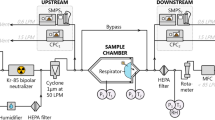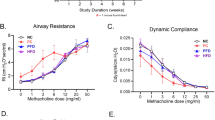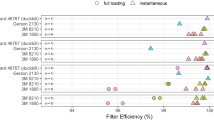Abstract
Animal-transfer and cage-changing stations are portable downdraft-filtered clean benches that have been specifically modified for small-rodent handling and cage changing from two or more sides, and that are advertised by their manufacturers as providing improved laboratory animal allergen control. The authors evaluated the dust containment capability of three such devices under exaggerated challenge conditions, compared design features, and conclude that animal-transfer stations can be a useful addition to an institutional laboratory animal allergy control program.
This is a preview of subscription content, access via your institution
Access options
Subscribe to this journal
We are sorry, but there is no personal subscription option available for your country.
Buy this article
- Purchase on Springer Link
- Instant access to full article PDF
Prices may be subject to local taxes which are calculated during checkout
Similar content being viewed by others
References
Lutsky, I.I. & Neuman, I. Laboratory animal dander allergy: I. An occupational disease. Ann. Allergy 35, 201–205 (1975).
Cockcroft, A., Edwards, J., McCarthy, P. & Andersson, N. Allergy in laboratory animal workers. Lancet 1, 827–830 (1981).
Dewdney, J.M. Allergy induced by exposure to animals. J. R. Soc. Med. 74, 928–932 (1981).
National Institute for Occupational Safety and Health. NIOSH Alert: Preventing Asthma in Animal Handlers. Publication No. 97-116 (NIOSH, Cincinnati, OH, 1998).
Bush, R.K., Wood, R.A. & Eggleston, P.A. Laboratory animal allergy. J. Allergy Clin. Immunol. 102, 99–112 (1998).
Edwards, R.G., Beeson, M.F. & Dewdney, J.M. Laboratory animal allergy: the measurement of airborne urinary allergens and the effects of different environmental conditions. Lab. Anim. 17, 235–239 (1983).
Kacergis, J.B. et al. Air quality in an animal facility: particulates, ammonia, and volatile organic compounds. Am. Ind. Hyg. Assoc. J. 57, 634–640 (1996).
Gordon, S., Tee, R.D., Stuart, M.C. & Newman Taylor, A.J. Analysis of allergens in rat fur and saliva. Allergy 56, 563–567 (2001).
Yamauchi, C., Obara, T., Fukuyama, N. & Ueda, T. Evaluation of a one-way airflow system in an animal room based on counts of airborne dust particles and bacteria and measurements of ammonia levels. Lab. Anim. 23, 7–15 (1989).
Ziemann, B., Corn, M., Ansari, A.A. & Eggleston, P. The effectiveness of the Duo-Flo bioclean unit for controlling airborne antigen levels. Am. Ind. Hyg. Assoc. J. 53, 138–145 (1992).
Jones, R.B. et al. The effect of relative humidity on mouse allergen levels in an environmentally controlled mouse room. Am. Ind. Hyg. Assoc. J. 56, 398–401 (1995).
Gordon, S., Wallace, J., Cook, A., Tee, R.D. & Newman Taylor, A.J. Reduction of exposure to laboratory animal allergens in the workplace. Clin. Exp. Allergy 27, 744–751 (1997).
Reeb-Whitaker, C.K., Harrison, D.J., Jones, R.B., Kacergis, J.B., Myers, D.D. & Paigen, B. Control strategies for aeroallergens in an animal facility. J. Allergy Clin. Immunol. 103, 139–146 (1999).
Reeb-Whitaker, C.K. & Harrison, D.J.F. Practical management strategies for laboratory animal allergy. Lab Anim. (NY) 28, 25–30 (1999).
Fisher, R., Saunders, W.B., Murray, S.J. & Stave, G.M. Prevention of laboratory animal allergy. J. Occup. Environ. Med. 40, 609–613 (1998).
Eggleston, P.A. et al. Task-related variation in airborne concentrations of laboratory animal allergens: studies with Rat n I. J. Allergy Clin. Immunol. 84, 347–352 (1989).
Gordon, S., Kiernan, L.A., Nieuwenhuijsen, M.J., Cook, A.D., Tee, R.D. & Newman Taylor, A.J. Measurement of exposure to mouse urinary proteins in an epidemiological study. Occup. Environ. Med. 54, 135–140 (1997).
Gordon, S., Fisher, S.W. & Raymond, R.H. Elimination of mouse allergens in the working environment: assessment of individually ventilated cage systems and ventilated cabinets in the containment of mouse allergens. J. Allergy Clin. Immunol. 108, 288–294 (2001).
Thulin, H., Bjorkdahl, M., Karlsson, A.S. & Renstrom, A. Reduction of exposure to laboratory animal allergens in a research laboratory. Ann. Occup. Hyg. 46, 61–68 (2002).
Acknowledgements
We gratefully acknowledge the Baker Company, NuAire Incorporated, and Labconco Corporation for temporary loan of their animal-transfer and cage-changing stations. We thank several individuals in the Yale Animal Resources Center, including Rod Storer and Andrew Feltham for hands-on assistance with the simulations, and Paul Simack, Beverly Frattini, Randie Prete, and others for their interest and encouragement. We also thank Deborah Ferry and Linda Mouning from our office for coordinating equipment deliveries and arranging certification contractor visits. Finally, we extend thanks to our anonymous reviewers for their constructive criticisms and insightful comments.
Author information
Authors and Affiliations
Corresponding author
Rights and permissions
About this article
Cite this article
Klein, R., Fontes, B. Containment Capabilities of Animal Transfer Stations. Lab Anim 32, 28–31 (2003). https://doi.org/10.1038/laban0803-28
Received:
Accepted:
Issue Date:
DOI: https://doi.org/10.1038/laban0803-28



